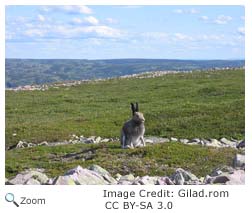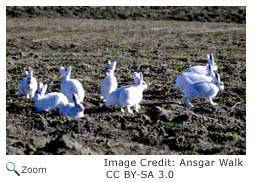Diet
The Arctic hare eats mostly woody plants like willow twigs and roots, but it also will eat sedges, mosses and berries.
Life Cycle

The Arctic hare mates between April and May. Males may box with their front legs over a female. Babies are born in late May through July. Young are born later in the northernmost part of the hare's range.
The female builds a nest in a depression in the ground, usually behind some rocks or behind a bush. She lines it with grass and her fur. She gives birth to between two to eight young. The mother will stay with the babies for the first couple of days. The young can protect themselves after that by remaining motionless among the rocks or vegetation, making it hard for predators like the wolf, lynx and Arctic fox to spot them.
When the babies are two to three weeks old, they will start to leave the nest, coming back only to nurse. Groups of up to 20 young hares may gather at one time to nurse. They are fully weaned when they are about eight to nine weeks old.
Behavior

Arctic hares are nocturnal. They often gather in groups of 10-60 hares when they are feeding. In the northernmost parts of their range, they have been known to gather in groups of up to 300.